![[MetroActive Music]](/music/gifs/music468.gif)
[ Music Index | Metro Santa Cruz | MetroActive Central | Archives ]
Idol Rich
Matinee idol pianist Brian Ganz brings an enthusiastic showmanship to an uneven Santa Cruz Symphony
By Scott MacClelland
PIANIST BRIAN GANZ is who you want for Chopin. The soloist for Sunday's Santa Cruz Symphony performance in Watsonville flashed all the youthful impulses implied by Chopin's Concerto in E Minor, a youthfully impulsive work itself, shot through with the matinee-idol hauteur that packed the bourgeois salons of 19th-century Europe.
Chopin's tunes, indulgent of long Bellini phrases laden with extravagant Bellini ornamentation, need a certain Las Vegas élan. Any approach without a touch of Liberace-style showmanship just wouldn't make sense. Not only does Ganz bring that to the party but he does so with sparkling enthusiasm and diamond-point clarity. Whether archly milking a phrase or nonchalantly tossing off bravura licks, Ganz was plainly enjoying himself. Likewise, conductor John Larry Granger and his musicians gave added cheek to the Schumannesque orchestral fabric. The concerto became the event of the day, and Ganz rewarded the cheering audience with Chopin's Aeolian Harp Etude as encore.
By comparison, Howard Hanson's Symphony no. 2 (Romantic) sounded bloated, the large wind/brass complement frequently overwhelming the strings, especially the violins. Chords inverted as minor lines stole primacy from major ones, significantly hurting Hanson's harmonic design. This complaint speaks largely to the acoustic contradictions of the Mello Center auditorium and proves that the reflective shell is still not properly deployed. (What appeared to be a sound-absorbing cloth hung behind the horns seemed to soften explosive volleys from that quarter.) Obviously, a heavily orchestrated work like the Hanson brings home the point that this hall, a basically dry room that lacks a real ceiling at proscenium height, needs more imaginative solutions than the Santa Cruz Symphony has discovered so far.
In addition, however, the musicians found themselves having a bad-hair day. Despite Granger's articulate podium language, ragged attacks and releases dogged the performance, and the number of cracked and choked notes in the winds attained notoriety.
Before the concert began, Granger, speaking from the stage, commented on the relationship between Howard Hanson and his pupil David Diamond, the former advising the latter not to go down the modernist path. In fact, Diamond's Incidental Music from Romeo and Juliet suffered almost none of the pitfalls that snared the Hanson piece. This was because Diamond scored more economically and transparently. Although his music gave the musicians fewer places to hide, they didn't need them.
Granger described Hanson as the neo-romantic and Diamond the neo-classicist. From a practical and historical perspective that means Hanson drew more on the German tradition and Diamond on the French. Indeed, French clarity proved a big plus in the Diamond, with its clashing overture, tender love duet (violin and viola) and colorful play of sonorities. Granger led both works from memory.
Concertmaster Kristina Anderson, scheduled this one time only, is apparently a candidate for the permanent position vacated last month by Terrie Baune. David Dally will take that role for the March 27 concert at the Santa Cruz Civic Auditorium.
Copyright © Metro Publishing Inc. Maintained by Boulevards New Media.
![]()

Piano Man: Pianist Brian Ganz complemented Chopin at last week's Santa Cruz Symphony concert.
From the February 10-17, 1999 issue of Metro Santa Cruz.